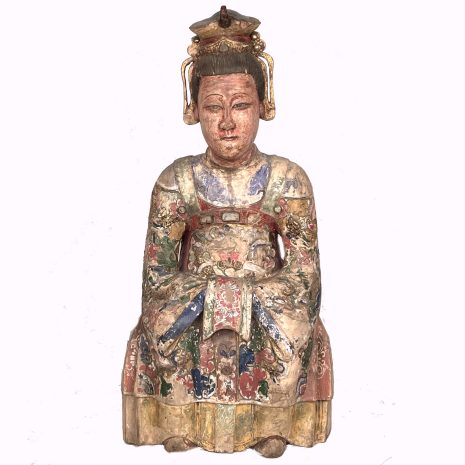Antique Imperial Mazu, Empress of Heaven, China, H: 31.5″ (16348) CALL FOR AVAILABILITY
Original price was: $3,250.00.$2,200.00Current price is: $2,200.00.
H: 31.5″ W: 16.25″ D: 10.5″ | CALL 213-568-3030 OR EMAIL [email protected] FOR SHIPPING.
Rare, antique Mazu portrayed as a sanctioned goddess revered in coastal China and Taiwan. Wears Empress headdress with a phoenix, Vibrant robes with shinning inset glass jewels to be seen at sea by sailors needing assistance. Authentic images are rare in the market
Description
Mazu has many names and titles. In China she is Mazu (Matsu) meaning ‘Ancestor Mother’ or ‘Eternal Mother’ and on southern China she is affectionately called ‘Ā-mā’ meaning ‘grandmother’ or ‘mother.’ In Taiwan she is ‘Holy Heavenly Mother’ and the ‘Empress of the Heavens’ and ‘Tianhou,’ Daughter of the Dragon. She is the most worshiped female Taoist deity, a syncretic deity embracing Taoist, Buddhist, Popular Religion and Confucian traditions and beliefs and a tutelary deity as Protectress of the Seas. It is claimed that she is one of the most important sea goddesses of Asia, and perhaps the world. Irwin defines her as one of the Great Chinese Goddesses who are imperially sanctioned feminine compassionate protectors who grant health, long life and safety to all in regardless of status. There are the two different versions of Mazu: a pious peasant shaman spiritual healer who assists seafarers and an imperially sanctioned elite deity in written traditions with the regal title Empress of Heaven bestowed on her during the Qing dynasty. She is recognized by her regal attire and ceremonial Empress hat and often on a decorative chair, now missing. This antique carving portrays the latter, a sanctioned goddess with many honorific titles. She wears a ceremonial Empress headdress with a phoenix, an official’s waist girdle and elaborate robes laced with bright and shinning inset glass jewels which allow her to be seen at sea by sailors needing her assistance. The “jewels” symbolize the rainbow that appeared across the sky when she died, and represent the Five Dhyani Buddhas, each associated with a different color. Also known as the Wisdom Buddhas, they are believed to be aspects of Shakyamuni Buddha and are widely followed in Vajrayana Buddhism. Raised curvilinear designs of strands made from incense ash highlight her robe that has two blue beads on the bottom of her sash and five inset mirrors – three across her chest and two inside flowers on her sleeves. A gilt headdress with raised threads inset with a mirror and topped by a phoenix sits on her intricate hair strands. When Matsu died a great rainbow appeared that indicated the presence of a dragon, which is reflected in this statue with a pair of raised dragons on the arms. The dragon symbolizes good fortunes and blessings and is a unifier of heaven and earth since it both quenches its thirst in the sea and flies to the sky. Colors were painted on a white cloth affixed to the wood, part of which is detached from the robe’s rear and the image is otherwise in very good condition from age and much use. Her face is awash with a newer finish applied over a darker red pigment which may have been reapplied in community temple. Imperial and local Taoist temples dedicated to her appeared in every maritime province throughout southeast China’s coastal regions, Southeast Asian Chinese communities, Vietnam and especially in Taiwan where there are over 3000 temples dedicated to her. Sailors embarking on voyages often stop in a local temple to pray to her for a safe and prosperous voyage. In Taiwan she was transformed from a young maiden to a “benevolent maternal figure what watches over the health of all people in Taiwan… and became the local folklore religion of Taiwan and continues to this day.” The Taiwanese government officially has recognized her as “the deity that leads the Taiwanese people in everyday life … which …led to her being included in the UNESCO list for unintelligible cultural heritage.” (Van de Kerhof). The large cavity in the back indicates the statue was consecrated in an eyeopening ceremony by a Taoist priest. Los Angeles has an elaborate and welcoming Taoist Thien Hau Matsu Temple filled with a huge impressive carving of Mazu in the front and other deities that is definitely worth visiting. This piece is featured on the VA Instagram page.
Sources:
Lee Irwin, “Divinity and Salvation: The Great Goddesses of China,” in Asian Folklore Studies, Indiana University, Vol. 49, 1990, pp 53-68.
Maup van de Kerkhof, “Mazu: Taiwanese and Chinese Sea Goddess”, History Cooperative, February 27, 2023, Accessed July 4, 2024
Claudia Monique, “Matsu/Mazu Goddess of Sea,” May 20, 2014.
Louisa Lim, “China’s Leaders Harness Folk Religion for Their Aims,” heard on All Things Considered NPR, July 23, 2010
Of Taiwan, “Mazu”, https://oftaiwan.org/culture/mazu/
Additional information
| Place of Origin | China |
|---|---|
| Period | Antique, Qing Dynasty |
| Date | 19-20th Century |
| Materials and Technique | Wood |
| Dimensions (inches) | Ht: 31.5” W: 16.25” D: 10.5” |
| Dimensions (metric) | Ht: 80.01cm W: 41.27cm D: 26.67cm |
| Condition | Very good, see description |
| Item Number | 16348XSKE |
| Shipping Box Size | Oversized. Call 213-568-3030 or email [email protected] for shipping. |










